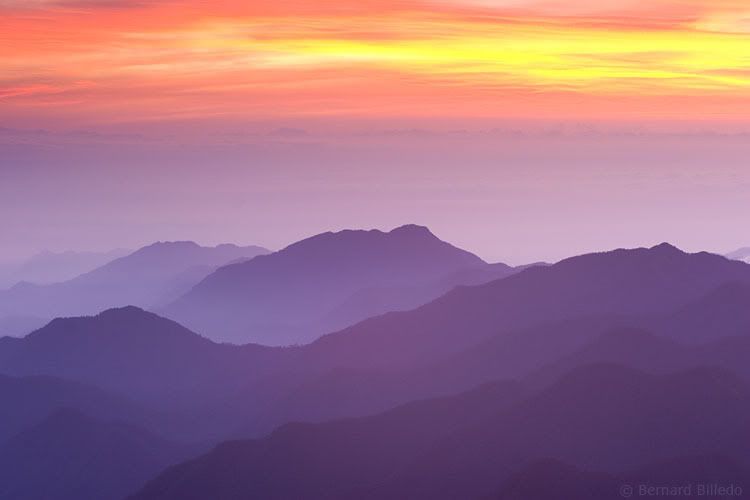TRIP DOWN MEMORY LANE 1: Crappy Writings
I squirm in acute embarrassment every time I reread stuff I wrote years back. Ganun ba talaga ako magsulat noon? Like a silly dumbass, bwehehehe.
Browsing through old files, I came across this one, written 20 years ago (in June 1987) and published in our company newsletter:
KASIBU: Fascination and Regret
 After what seemed to me an endless stretch of drab, dry plains, my first glimpse of Nueva Vizcaya left me almost breathless. Having lived in a town where the sea is practically backdoor, I was a bit intimidated by the grandeur of great mounds of earth soaring to incredible heights. The gracefully zigzagging highway cut along the mountainsides nearly killed me, though: the car turns to the right and I slip sideways to the left; it turns to the left and I’m slammed right back to where I originally sat. For more than an hour and a half, I slipped from side to side until I thought the seat’s gonna rub me out altogether.
After what seemed to me an endless stretch of drab, dry plains, my first glimpse of Nueva Vizcaya left me almost breathless. Having lived in a town where the sea is practically backdoor, I was a bit intimidated by the grandeur of great mounds of earth soaring to incredible heights. The gracefully zigzagging highway cut along the mountainsides nearly killed me, though: the car turns to the right and I slip sideways to the left; it turns to the left and I’m slammed right back to where I originally sat. For more than an hour and a half, I slipped from side to side until I thought the seat’s gonna rub me out altogether.
But if the highway’s a less-than-pleasant experience, the road to Kasibu town is definitely a driver’s nightmare. The one-lane trail undulates like a starving colon, shoots up 60 degrees to the sky, and snakes along the treacherous mountainsides where a slight miscalculation will send you hurtling several thousand feet down, face to face with St. Peter. We crossed so many streams I lost count, and the ride’s so bumpy I was positive my behind’s going to stay purple for at least a week! It didn’t rain for two days, fortunately, or we’d have plodded along at a snail’s pace the way that road reportedly turns marshmallow during heavy rains.
Kasibu itself is a rather sleepy town set on gently sloping terrain with lush vegetation all around. A sprinkling of cattle graze idly on the mountainsides, giving us the illusion of trampling along Marlboro Country. This was miserably shattered, though, by the realization that it was undoubtedly kalabasa country through and through. Stretches of squash plantations occupy the valley with a sprinkling of rice fields and some corn.
It is sad to note, however, that for such a lovely place it is rapidly losing its mantle of plant life. The once verdant hills that housed all sorts of animal life are now tragically bald, its beauty diminished. A native spoke longingly of how it was only a few years ago: trees abound in the area, sheltering deer and wild boars. Hunting grounds were plentiful. Then came the logging concessions. Trees were felled right and left. Nothing was planted in their place, or if there were, these were burned to the ground by the kaingeros who dig in after the loggers moved. They cleared the area and planted it with squash. After perhaps two croppings, the land is no longer as fertile as before so they move on to other areas and replicate their operations, leaving behind a trail of waste and unproductiveness. Stripped mountains stand mute: helpless witnesses to the wanton destruction of their protective covering.
When are people ever going to learn? With the reckless destruction of our forests, severe drought hits large farming areas during the dry season. When the rainy season comes, destructive floods sweep across the same areas, causing millions of pesos worth of damage to crops and properties. Soil erosion takes its toll, turning thousands of hectares of over-grazed pastures into barren land. Nutrient-laden topsoil on which plants grow are washed away, leaving the area an unproductive waste. Sedimentation of lakes and rivers follow, for much of the sediment comes from denuded mountains and hills.
What will we have then? What can we leave our children and our children’s children? Answers to these questions lie ahead in the future. Whether or not our organization can help shape favorable answers is yet to be seen.
Browsing through old files, I came across this one, written 20 years ago (in June 1987) and published in our company newsletter:
KASIBU: Fascination and Regret
 After what seemed to me an endless stretch of drab, dry plains, my first glimpse of Nueva Vizcaya left me almost breathless. Having lived in a town where the sea is practically backdoor, I was a bit intimidated by the grandeur of great mounds of earth soaring to incredible heights. The gracefully zigzagging highway cut along the mountainsides nearly killed me, though: the car turns to the right and I slip sideways to the left; it turns to the left and I’m slammed right back to where I originally sat. For more than an hour and a half, I slipped from side to side until I thought the seat’s gonna rub me out altogether.
After what seemed to me an endless stretch of drab, dry plains, my first glimpse of Nueva Vizcaya left me almost breathless. Having lived in a town where the sea is practically backdoor, I was a bit intimidated by the grandeur of great mounds of earth soaring to incredible heights. The gracefully zigzagging highway cut along the mountainsides nearly killed me, though: the car turns to the right and I slip sideways to the left; it turns to the left and I’m slammed right back to where I originally sat. For more than an hour and a half, I slipped from side to side until I thought the seat’s gonna rub me out altogether.But if the highway’s a less-than-pleasant experience, the road to Kasibu town is definitely a driver’s nightmare. The one-lane trail undulates like a starving colon, shoots up 60 degrees to the sky, and snakes along the treacherous mountainsides where a slight miscalculation will send you hurtling several thousand feet down, face to face with St. Peter. We crossed so many streams I lost count, and the ride’s so bumpy I was positive my behind’s going to stay purple for at least a week! It didn’t rain for two days, fortunately, or we’d have plodded along at a snail’s pace the way that road reportedly turns marshmallow during heavy rains.
Kasibu itself is a rather sleepy town set on gently sloping terrain with lush vegetation all around. A sprinkling of cattle graze idly on the mountainsides, giving us the illusion of trampling along Marlboro Country. This was miserably shattered, though, by the realization that it was undoubtedly kalabasa country through and through. Stretches of squash plantations occupy the valley with a sprinkling of rice fields and some corn.
It is sad to note, however, that for such a lovely place it is rapidly losing its mantle of plant life. The once verdant hills that housed all sorts of animal life are now tragically bald, its beauty diminished. A native spoke longingly of how it was only a few years ago: trees abound in the area, sheltering deer and wild boars. Hunting grounds were plentiful. Then came the logging concessions. Trees were felled right and left. Nothing was planted in their place, or if there were, these were burned to the ground by the kaingeros who dig in after the loggers moved. They cleared the area and planted it with squash. After perhaps two croppings, the land is no longer as fertile as before so they move on to other areas and replicate their operations, leaving behind a trail of waste and unproductiveness. Stripped mountains stand mute: helpless witnesses to the wanton destruction of their protective covering.
When are people ever going to learn? With the reckless destruction of our forests, severe drought hits large farming areas during the dry season. When the rainy season comes, destructive floods sweep across the same areas, causing millions of pesos worth of damage to crops and properties. Soil erosion takes its toll, turning thousands of hectares of over-grazed pastures into barren land. Nutrient-laden topsoil on which plants grow are washed away, leaving the area an unproductive waste. Sedimentation of lakes and rivers follow, for much of the sediment comes from denuded mountains and hills.
What will we have then? What can we leave our children and our children’s children? Answers to these questions lie ahead in the future. Whether or not our organization can help shape favorable answers is yet to be seen.


